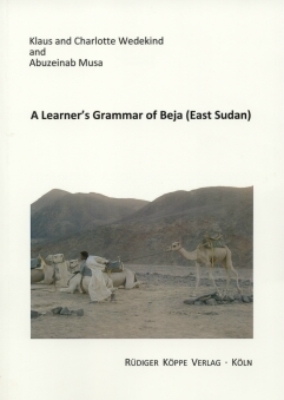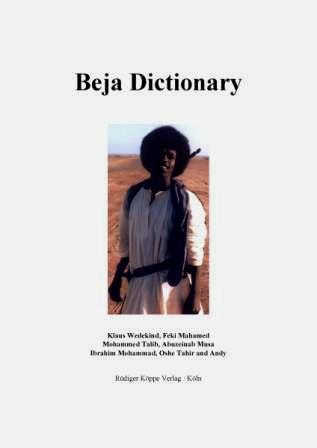

A Learner’s Grammar of Beja (East Sudan)
Grammar, Texts and Vocabulary (Beja-English and English-Beja)
Author: Klaus Wedekind †, Charlotte Wedekind, Abuzeinab Musa. Series edited by: Wilhelm J.G. Möhlig †, Bernd Heine.
Series: Study Books of African Languages Volume 17
200710 pp. Roman, 279 pp.
Lessons with text examples (mp3 audio files) and word lists Beja-English/English-Beja, numerous tables and charts, subject index
Text language(s): English
E-book
€ 69.80
Buy 'A Learner’s Grammar of Beja (East Sudan)' as a downloadable PDF document directly from our online shop »
Beja holds a special position within the Afro-Asiatic languages, since it is the only Cushitic language classified as North Cushitic. Beja speakers number about 1 million – but ethnic Beja people may be as many as 2 or 3 million. They live in Southern Egypt, Eastern Sudan and Northern Eritrea. The Atmaan dialect – one of the Beja varieties which is mainly spoken in the Sudan – serves as the basis for this book.
The theoretical orientation of this book is functional and the progression is learner-oriented – it proceeds from small, unstructured items to more and more complex structures. The initial section on Language Basics offers simple, holistic items for immediate, unanalyzed basic communication. The next section on Nouns and Phrases deals with nominal words and noun phrases. At the end of this section, there are short nominal clauses which allow the speaker to “define” or “describe” things.
The third section is on Verbs and Clauses. It starts with clauses which consist of only one verb, and progresses to clauses which also have objects, adverbs, auxiliaries or subordinate clauses – i.e. complex sentences. In every section there are “grammatical notes”, “tables”, “examples”, “paradigms”, and “conversations”. The “conversations” and the “texts” always include more than what has been introduced in the preceding sections.
In this way the book does not appeal to the analytical understanding alone; it also challenges the “intuitive”, “naive” use of the language in its communicative complexity. An analytical approach is possible, because all conversations and texts are accompanied by interlinear translations with morpheme-by-morpheme glosses. The annex consists of interlinearized texts and an index.
The downloadable files comprise (a) a dictionary of about 7,000 items, and (b) sound files (mp3). The dictionary covers all words found in this E-Book – plus those items which are known to have a relatively high frequency in the everyday language. The sound files cover all Beja data of the grammar and the text-collection.
Under Audio (at the bottom) you will find some sound files of the E-Book as example.
Under these links you will find a comprehensive Beja Dictionary (Beja-English-Arabic) and further descriptions of Beja (Bedauye / Bedawiet) in various paper collections:
Accompanying material:
Cross-reference:
- Afrikanische Sprachen im Brennpunkt der Forschung
(ISBN 978-3-89645-121-7 ) - Colloque international sur les langues couchitiques et les peuples qui les parlent – International Conference on Cushitic Languages and Peoples
(ISBN 978-3-89645-489-8 ) - Multidisciplinary Views on the Horn of Africa
(ISBN 978-3-89645-683-0 ) - Omotic and Cushitic Language Studies
(ISBN 978-3-89645-482-9 ) - Proceedings of the 6th WOCAL World Congress of African Linguistics, Cologne, 17-21 August 2009
(ISBN 978-3-89645-199-6 ) - SUGIA Sprache und Geschichte in Afrika
(ISBN 978-3-927620-22-3 ) - Tigre Studies in the 21st Century – Tigre-Studien im 21. Jahrhundert
(ISBN 978-3-89645-682-3 )
Reviews
Die Kenntnis des Bedauye [...] steht im Missverhältnis zur großen Bedeutung dieser Sprache für die interne Entwicklung des Kuschitischen und die Rekonstruktion des Ur-Semitohamitischen. Nach den großen Beschreibungen des 19. Jh. [...] hat es im 20. Jh. nur Teilbeschreibungen [...] gegeben [...].
So fehlte bis jetzt eine Grammatik dieser Sprache, nach der man anhand von linguistisch nicht verklausulierten Regeln und einfachen Beispielsätzen diese Sprache erlernen kann. Eine solche Grammatik liegt nun vor. Es ist die Einfachheit der Darstellung zu loben, hätte doch Klaus Wedekind zweifelsohne alles auch viel linguistischer ausdrücken können. [...]
Das Besondere an dieser Arbeit besteht darin, dass man sich alle von dem ostsudanischen Gewährsmann gesprochenen Beispielsätze, Paradigmen und Texte auf der beigefügten CD anhören kann. Damit wird für das Erlernen kuschitischer Sprachen (außer dem Somali) ein neues Kapitel aufgeschlagen.
Rainer Voigt in Aethiopica, 12/2009, 297-299
A new book on the Beja language is de facto good news when one considers the scarcity of the publications on this Cushitic language [...]
If some other Cushitic languages have already their “complete language course”, the book written by Klaus and Charlotte Wedekind with Abuzeinab Musa can be considered as the first Beja grammar with a declared pedagogical aim.
Didier Morin in Afrika und Übersee, 90/2008, 273-280
The entire work reflects the wide experience and deep knowledge of the authors both as language learners, teachers, and linguists. I give the book top rating as the most impressive learner’s grammar that I ever saw. I also recommend it for field linguists who are not in the slightest interested in Beja, as a model of how to write a grammar that combines full descriptive clarity with a way of presenting the knowledge in such a way that a dedicated learner has no excuse for not becoming an expert him or herself, interested in both the language and the culture.
Kjell Magne Yri in Zeitschrift der Deutschen Morgenländischen Gesellschaft, 162/2, 2012, 471-474
Audio:
| « back | Print version | [top] |
 Books
Books Audio
Audio Biographies
Biographies Series
Series Festschrifts
Festschrifts Journals
Journals